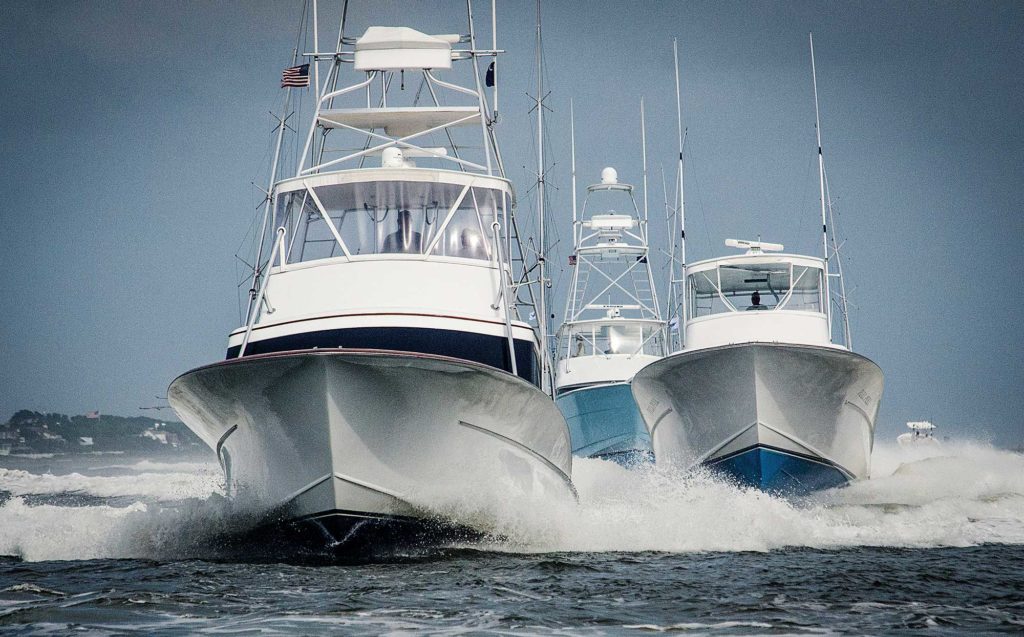
The low-slung, wind-swept and starkly beautiful Sea Islands separate coastal South Carolina from the Atlantic Ocean, buffering the Palmetto State’s Lowcountry region from all but the nastiest weather. With 187 miles of coastline and natural ports in Georgetown and Charleston, the state’s intimate relationship with history and the sea cannot be overshadowed.
South Carolina is perhaps most famous as the starting point of the American Civil War, where Confederate troops fired upon the Union soldiers defending Fort Sumter in the mouth of Charleston harbor in 1861. Fifteen decades later, outrigger-lined sport-fishermen rather than square-rigged barkentines are a more familiar sight. The state has an equally rich history in the blue water, yet most are unfamiliar with this part of the East Coast.
Billfishing in this part of the world is not for the faint of heart but rather for the passionate, for it requires passion to remain dedicated. While it can be considered very good, the fishing is not on the level of a foreign hot spot where the bills seem to rattle themselves against the boat gunwales in anticipation of being caught. No, here in South Carolina, captains must apply themselves to the pursuit of marlin and sailfish, and anglers have to be sharp enough to convert a limited number of bites into releases. But it’s that dedication that makes the days even sweeter when a blue marlin or two does wander into the spread.
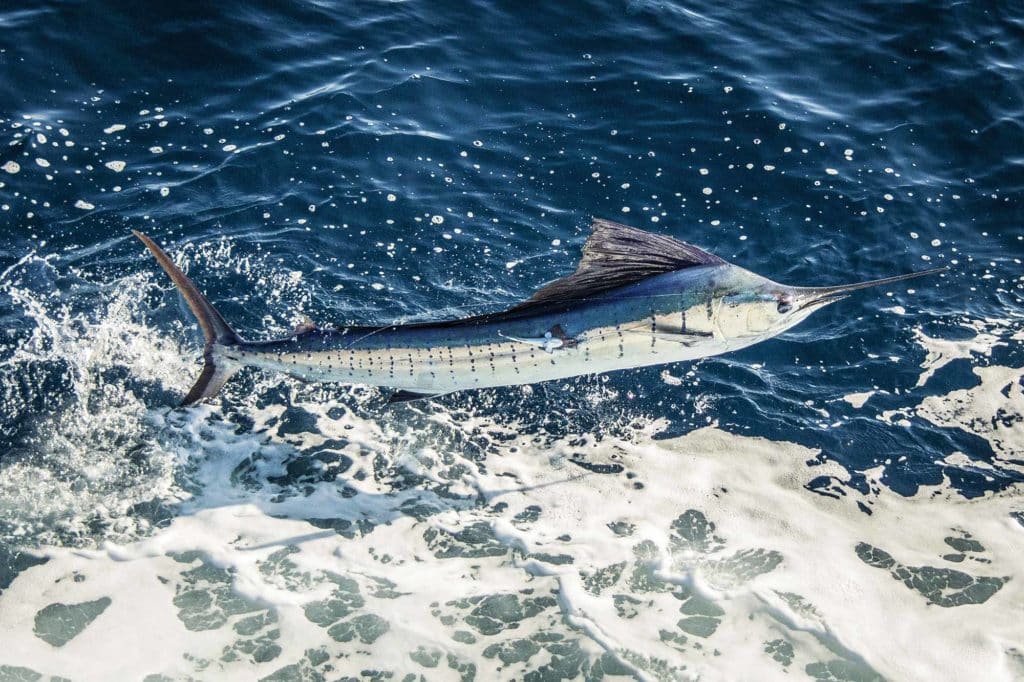
A Historic Start
The first billfish caught in South Carolina waters was a sailfish landed on July 3, 1962, by Robert Stephson, fishing on Georgia May out of Little River, South Carolina. Two years later, Katherine “Cappie” Fitzgerald landed a 230-pound blue marlin in 1964, proof that bluewater species could be encountered with regularity in these waters. For the most part, though, as with other parts of the Carolinas, charter parties were more interested in targeting tuna and mahimahi than fishing strictly for marlin.
But, as the offshore fishery gained momentum in the 1970s and ’80s, the focus soon turned to a way to showcase the action as well as raise funds for conservation projects. The South Carolina Governor’s Cup Billfishing Series was created in 1989 by Carroll A. Campbell Jr., who was the state’s governor. The series was inextricably linked to sport-fishing interests within the state, and the ranks of the tournament series swelled with those not only bent on a big win but those who simply enjoyed the competition and camaraderie that tournament fishing breeds among sportsmen and -women.
In 1995, then-governor David M. Beasley made the series an official program of the South Carolina Department of Natural Resources, effectively ensuring its longevity. A perpetual trophy was established, on which the winners’ names are engraved; the trophy resides in the state’s Department of Natural Resources. An advisory board of directors oversees the operation of the tournaments, which are operated as a nonprofit in cooperation with the Harry R. E. Hampton Memorial Wildlife Fund. Currently, the Governor’s Cup Billfishing Series comprises five high-profile billfish tournaments. A point system ensures billfish releases will nearly always determine the winners of the annual series; landed blue marlin must meet a minimum short measurement of 105 inches, which is 6 inches above the federal minimum requirement and demonstrates the strong dedication to conservation within the series. In 2018, the Governor’s Cup Billfishing Series celebrates its 30th anniversary.
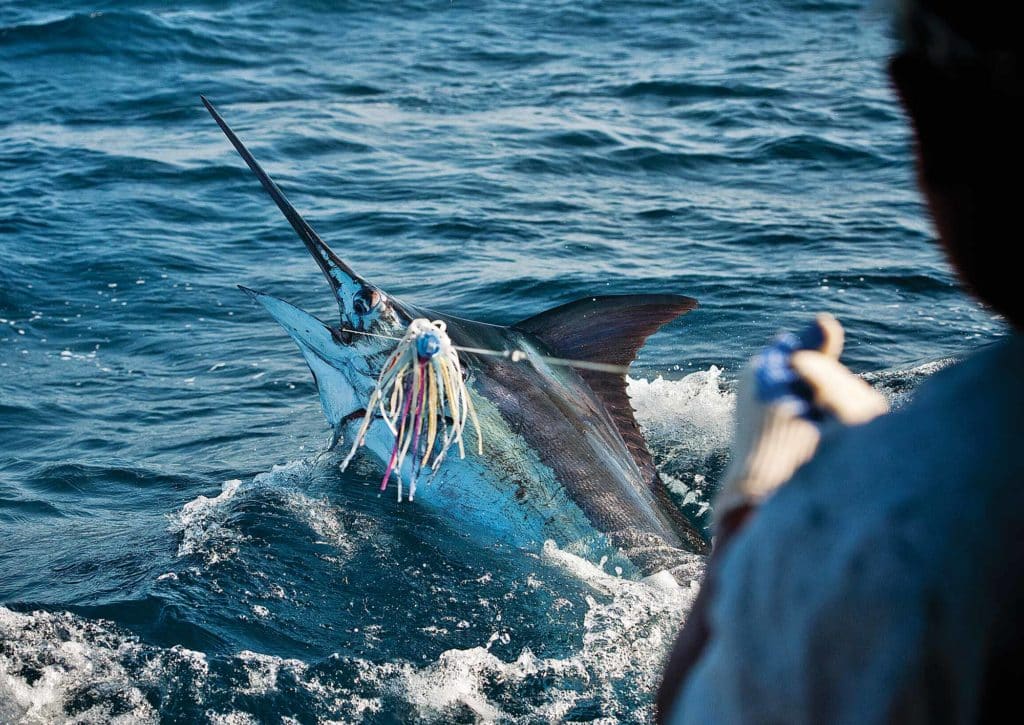
Funding Conservation
The series also helps fund several important conservation projects throughout the state. A portion of the team entry fees from each tournament goes to the Harry R. E. Hampton Memorial Wildlife Fund, earmarked for marine conservation projects, and over $255,500 has been awarded in scholarships and research grants for bluewater species since 1989.
As release-oriented fishing became the norm, the series shifted from over 90 percent billfish mortality to well over 90 percent release; in 2017, the release rate was 99.1 percent. As more of those fish were tagged, a new understanding of the billfish species began to emerge. A South Carolina-tagged blue marlin was recaptured off Brazil, a trans-equatorial crossing of some 4,320 nautical miles.
Series conservation funds also financed the construction and deployment of three artificial reefs as part of the Charleston Deep Reef/South Carolina Memorial Reef Project, which was deployed in 2014. The reef project serves as a way to remember those who held bluewater fishing dear to their hearts, and families can improve offshore habitat while also honoring their loved ones. The Charleston Deep Reef is a Type II marine protected area, in which bottomfishing is prohibited but surface trolling is allowed. During the 2017 Carolina Billfish Classic in Charleston, most of the billfish released in the tournament were caught in close proximity to these structures, which were covered with bait despite being created just a few years prior. The state’s conservation measures were paying dividends almost immediately in terms of improved fishing.
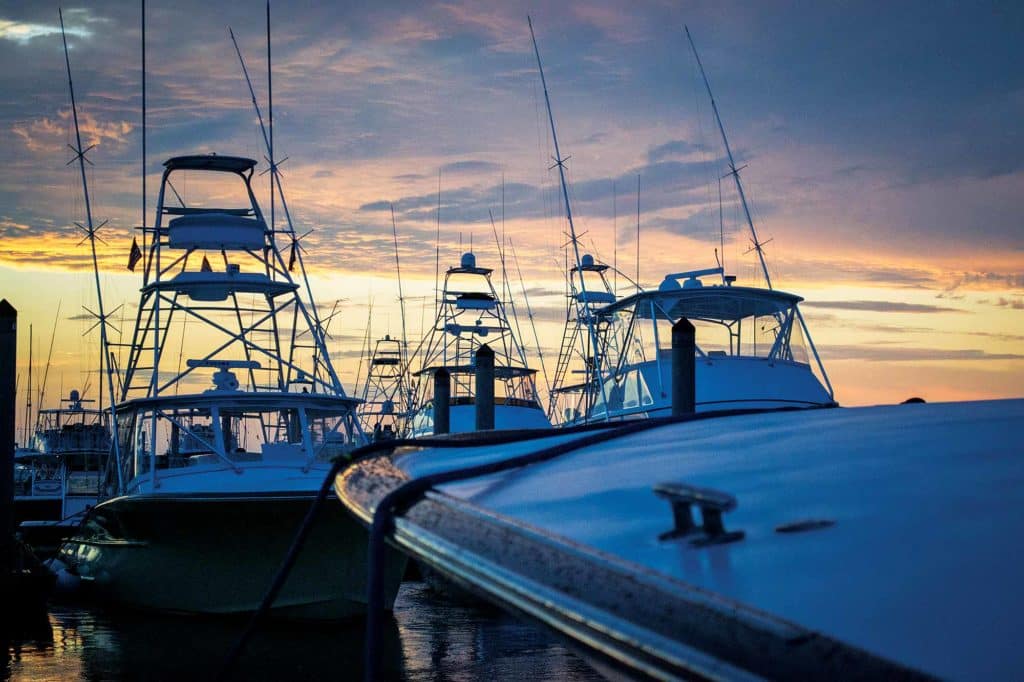
Long Runs, Hot Fishing
Steve Leasure is chairman of the Governor’s Cup advisory board of directors as well as co-owner and captain of the 57-foot Sea Island Summer Girl. He’s seen the fishing improve over the years, thanks in part to changing customs as well as the improved habitats. “I started fishing offshore in South Carolina in the early ’80s while I was in high school,” he says. “Back then, catching a billfish was a huge deal and a big celebration on the boat. Today, if you don’t get a crack at one in a day then it’s disappointing. I’m a firm believer in circle-hook fishing and really feel that release practices have helped the fishing tremendously.” In his six years on the advisory board, and his first as chairman this year, he says the biggest changes have been keeping the many lady and youth anglers involved in the tournament series, as well as the ongoing conservation aspects.
“In fall 2017, we added a third deployment of materials in the Memorial Reef, which consisted of a local bridge structure,” he reports. “All materials are in water ranging in depth from 290 to 400 feet, placed about 1 mile apart in a 4-by-6-mile area about 52 miles off Charleston. During the tournaments, as well as for recreational fishing, it’s a hot spot, and the release numbers show how well it’s paying off.”
Graham Eubank’s Sportin’ Life, a 61-foot Garlington, is a familiar sight off the South Carolina coast; the boat’s skipper, Capt. Mike Glaesner, has plied the state’s waters since the 1960s and says the blue marlin fishing can be as good as anywhere on the East Coast. “While our peak season for blues is from April through August, you have a good shot at billfish from April all the way until November,” he says. “In the early days, I can remember seeing sails and marlin free-jumping as far as you could see on some occasions; as our techniques and boats have improved, so has the catching. Our best day was in the Georgetown tournament in the early ’80s when we caught four out of six blue marlin bites, but this has been done at least two other times by other boats.” Glaesner has also hooked tripleheaders of blue marlin on three different occasions throughout the years. And it’s getting better: “In the 2017 Bohicket tournament, the blue marlin bite was epic,” he says. “Almost everyone was getting multiple bites, and some boats were having four or five shots at blues a day.”
With a gently sloping bottom and not as much underwater structure as in other destinations, the run to the fishing grounds can be somewhat long. The action starts about 45 to 50 miles offshore, with the best fishing generally between 50 and 200 fathoms, says Glaesner. “The Georgetown Hole is an exception though,” he says, “because the water drops from 30 fathoms to over 100 fathoms very quickly there.” He says ideal conditions for him occur when the western edge of the Gulf Stream is about 60 to 65 miles offshore, with an eddy spinning inshore on a southwestern tide. “I’ve found that marlin prefer to feed on the edge or inside the Stream,” he says. “Sometimes, you can find a distinct edge with a severe color and temperature change, which will normally also have lots of sargassum weed. The best edge I’ve ever fished off our coast had a 7-degree temperature change, with dark-blue water on offshore side and green on inside. The edge was in 50 fathoms, and the fishing was insane.”
Glaesner says the white marlin generally show up from May through July and the sailfish can be found from May through December, although big numbers are usually caught in June and into the fall. “We can have a world-class sailfish bite, with double-digit days not too uncommon,” he reports.
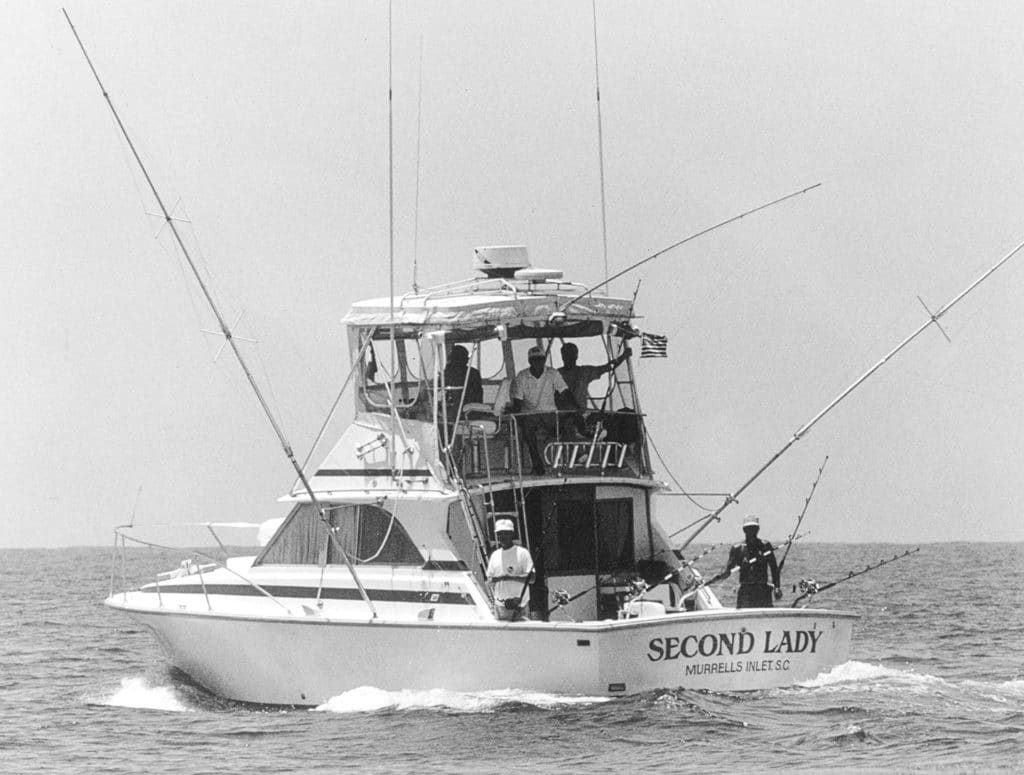
On the Hunt for Marlin
When he’s running Summer Girl for a day of fishing, Leasure looks for good water conditions. “Blue water or a color change is great, but usually we’ll start with a 45-mile run to the 150- to 180-foot ledge for wahoo and blackfin tuna,” he says. “In the spring and summer, we’re running 50-plus miles to 300- to 1,800-foot water. Billfish usually show up there in April, with the best numbers in June, July and August, although one team caught the first sailfish of the year off our coast on January 21, 2018.” He echoes Glaesner’s sentiments on the excellent fall fishing as well. “My best day was actually December 13, where we caught a super slam: two swords plus one blue, two whites and a sail,” he says. “Another good trip was in November, where we released two whites and 15 sailfish.” As with any other East Coast fishery, find productive water with bait and signs of life and the chances are very good that the marlin and sailfish will be nearby.
Because the fish can be spread out over a wide area, those targeting blue marlin tend to deploy a spread of artificial lures on heavy tackle in order to cover more ground. However, those fishing with a standard spread of circle-hook-rigged ballyhoo, dredges and teasers are more likely to encounter a variety of species, including yellowfin and blackfin tuna, mahimahi, wahoo, sailfish and white marlin. Daytime deep-dropping for swordfish is also gaining in popularity, giving teams the opportunity to chalk up another species for a grand slam. For those interested in filling the fish box, the action for wahoo can be very good in the winter, especially on the offshore ledges and drop-offs.
Aside from the offshore action, South Carolina also offers some of the finest cuisine in the world, with Charleston home to arguably some of the best dining in the South. The city is chockablock with plenty of outstanding eateries, from five-star to quaint seafood and barbecue shacks — it’s rare to find a bad meal in this town. The Charleston City Marina is also home to one of the longest docks on the East Coast at over 1,500 feet, hence the name Megadock for its hometown tournament held in July. Each of the marinas that host the Governor’s Cup tournaments have great facilities for visiting teams, and the camaraderie is simply unbeatable. Families with lady and youth anglers are especially welcome — it’s a far cry from the cutthroat, win-at-all-costs big-money tournaments found elsewhere.
Read Next: Stunning Boats of the South Carolina Governor’s Cup Series
As Sportin’ Life‘s Glaesner says, “How can you beat a week in South Carolina, staying in a great marina, fishing a really fun tournament, meeting terrific people, dining in some of the world’s best restaurants and also catching blue marlin?” It is a sentiment that we agree with, wholeheartedly.
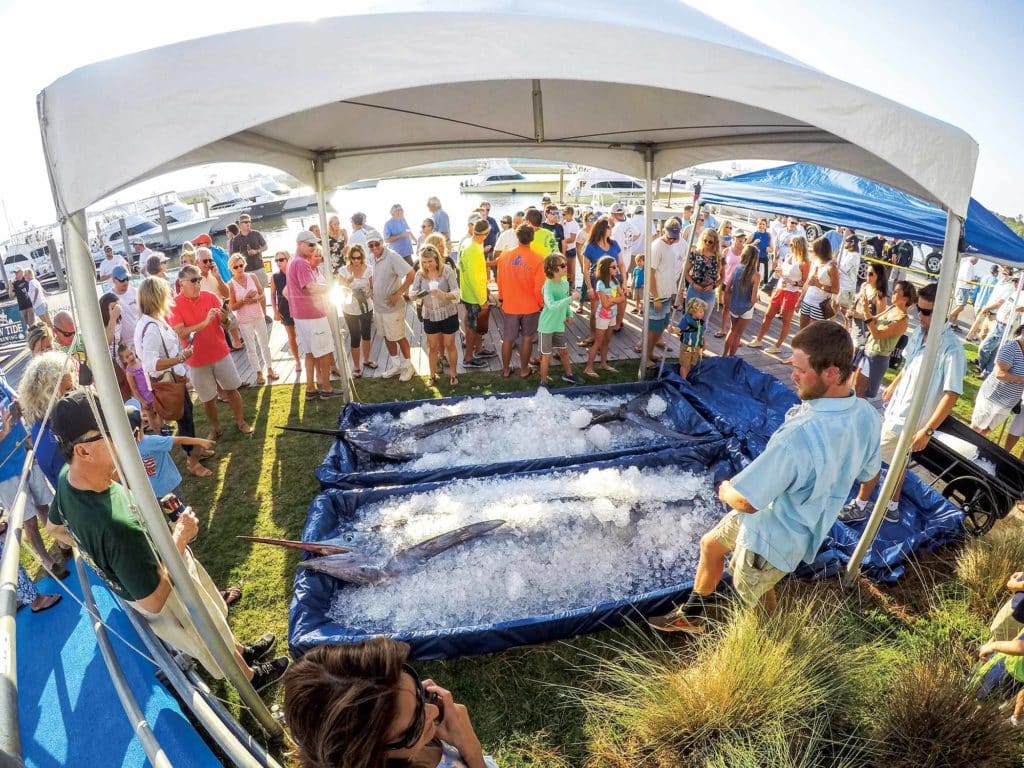
No Wanton Waste
While many tournaments allow the harvest of blue marlin, few outline what is to be done with the fish after it is weighed. All too often it is returned to the sea for disposal. However, the South Carolina Governor’s Cup Billfishing Series is different in that it has a wanton-waste rule for its events. Tournament coordinator Amy Whitaker Dukes, of the South Carolina Department of Natural Resources, says the rule requires that the marlin remain cold and in edible condition after capture. “Fishing teams either use a large insulated fish bag or wrap the fish in iced towels once it’s boated,” she says. “After the fish is measured at the dock, to ensure it meets the 105-inch minimum, and weighed, it’s placed on ice while biologists take samples, examine the stomach contents and remove the otoliths. Once that process is complete, the boat crew has three hours to properly clean the fish. Series rules ensure that if you’re going to take a marlin in a tournament, you will show the fish respect in making sure it is consumed and not wasted. If any of the above steps are not followed, the team is disqualified. We feel this showcases our strong commitment to conservation and research.”
2018 South Carolina Governor’s Cup Billfishing Series
Bohicket Marina Invitational Billfish Tournament
May 9-12, Seabrook Island
Georgetown Blue Marlin Tournament
May 23-26, Georgetown
Carolina Billfish Classic
June 20-23, Mount Pleasant
Megadock Billfishing Tournament
July 11-14, Charleston
Edisto Invitational Billfish Tournament
July 18-21, Edisto Beach







